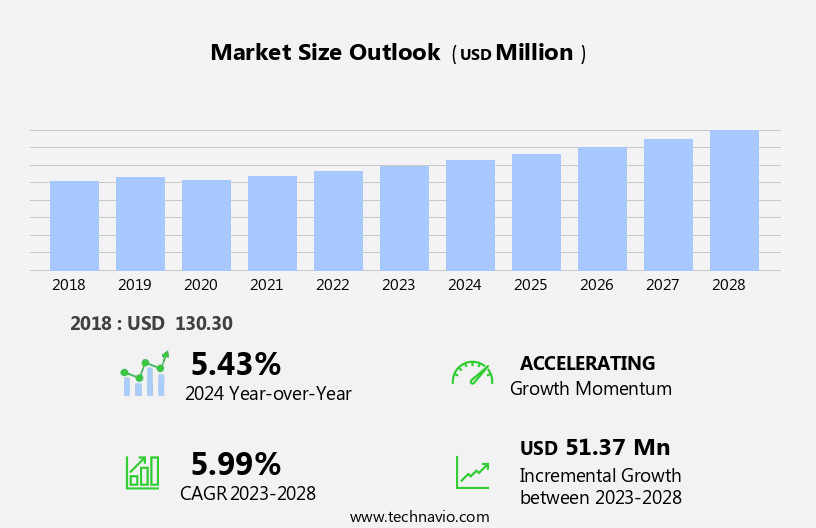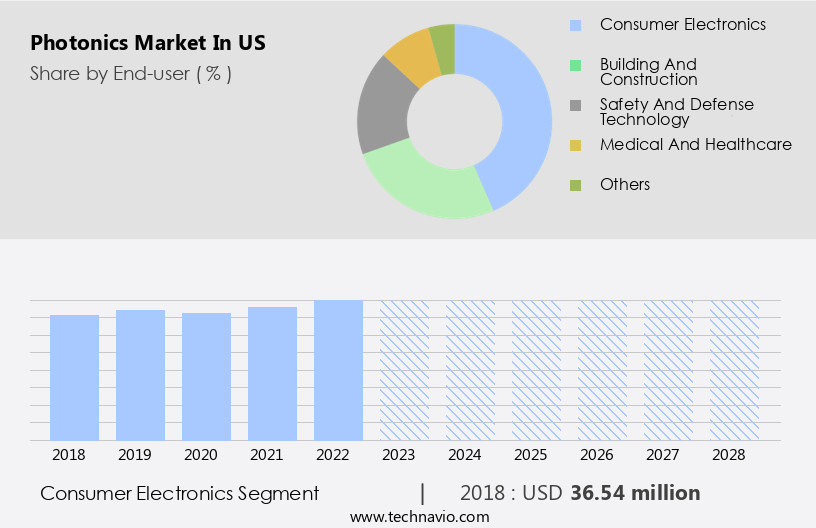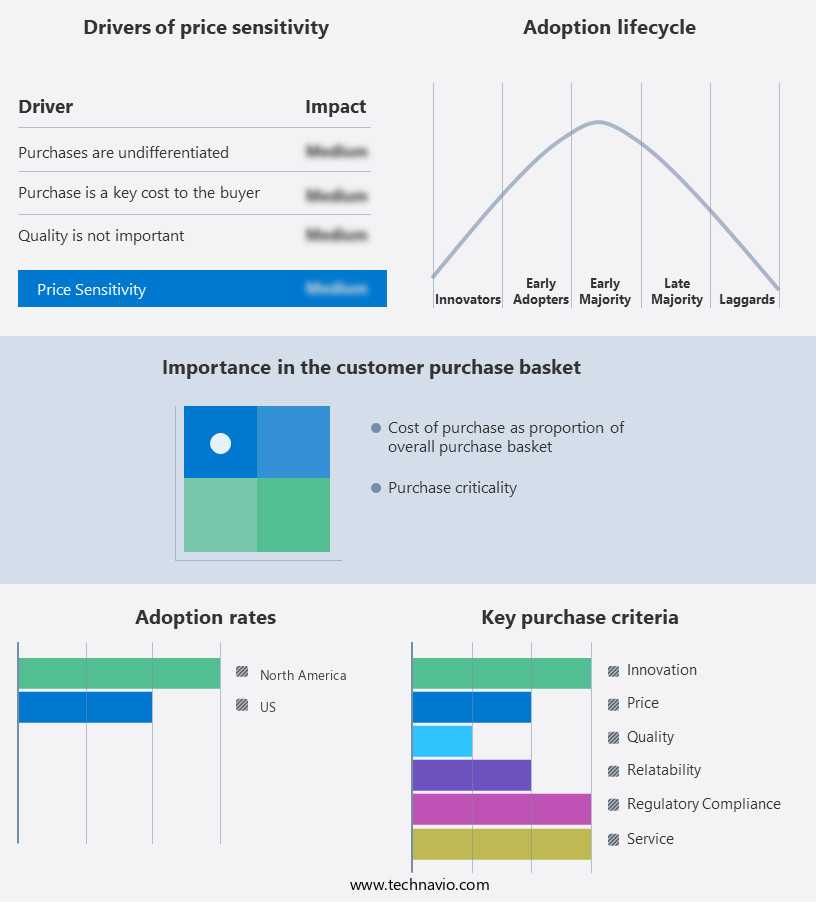US Photonics Market Size 2024-2028
The us photonics market size is forecast to increase by USD 51.37 million, at a CAGR of 5.99% between 2023 and 2028.
- The Photonics Market in the US is experiencing significant growth, driven by the emergence of new silicon-based applications. This technological advancement is fueling innovation and expanding the scope of photonics in various industries, including telecommunications, healthcare, and energy. The US, being a hub for technological innovation, is at the forefront of these developments. However, the market faces a notable challenge in the form of the high cost of photonics-enabled devices. This obstacle poses a significant barrier to widespread adoption, particularly in industries with tight budgets or price-sensitive consumers. To capitalize on the market opportunities and navigate these challenges effectively, companies must focus on cost reduction strategies, such as economies of scale, process optimization, and technology advancements.
- Additionally, collaborations and partnerships with key industry players can help share the development costs and accelerate time-to-market. By addressing these challenges, companies can tap into the vast potential of the photonics market and establish a competitive edge.
What will be the size of the US Photonics Market during the forecast period?

Explore in-depth regional segment analysis with market size data - historical 2018-2022 and forecasts 2024-2028 - in the full report.
Request Free Sample
- The photonics market in the US is characterized by continuous innovation and advancements in various applications, including optical communications, bioimaging, and quantum information processing. Optical couplers play a crucial role in connecting different optical components, while photonic integrated circuits enable compact and efficient systems. Optical bioimaging techniques, such as confocal microscopy and super-resolution microscopy, revolutionize biomedical research. Optical manipulation methods, including optical trapping and optical tweezers, facilitate precise control of particles. Quantum information processing and satellite communications rely on advanced technologies like nonlinear optics and ultrafast optics. Data center optics and optical networking drive the demand for high-speed optical interconnects and wavelength division multiplexing.
- Optical sensors and fiber optic sensors are integral to various industries, from environmental monitoring to industrial automation. Terahertz photonics and silicon photonics offer promising solutions for emerging applications, while laser scanning microscopy and optical filters enhance imaging capabilities. Optical switches and optical demodulators ensure efficient data transmission, and fiber Bragg gratings provide wavelength selectivity. Structured illumination microscopy and light field imaging expand the horizons of optical microscopy. Optical nanometrology and Raman amplifiers contribute to the development of advanced measurement and amplification technologies. Overall, the US photonics market is a dynamic and diverse landscape of technological innovation.
How is this market segmented?
The market research report provides comprehensive data (region-wise segment analysis), with forecasts and estimates in "USD million" for the period 2024-2028, as well as historical data from 2018-2022 for the following segments.
- End-user
- Consumer electronics
- Building and construction
- Safety and defense technology
- Medical and healthcare
- Others
- Product
- WDM filters
- Optical modulators
- Optical interconnects
- Photo detectors
- Others
- Application
- Information and communication technology
- Displays
- Photovoltaic
- Biophotonics
- Others
- Geography
By End-user Insights
The consumer electronics segment is estimated to witness significant growth during the forecast period.
In the dynamic US photonics market, consumer electronics hold a substantial segment with a broad user base reaping the benefits of photonics-driven devices. Photonics technology significantly enhances the capabilities, functionality, and user experience of various consumer electronics products. A prime application within this sector is displays, where photonics brings about a noticeable difference in smartphones, tablets, televisions, and augmented reality (AR) devices. Technologies such as organic light-emitting diodes (OLEDs), liquid crystal displays (LCDs), and micro LEDs, which are photonics-based, offer vibrant colors, high resolution, and energy efficiency. These advanced displays cater to the increasing demand for premium-quality visual output in consumer electronics, providing users with immersive viewing experiences.
Photonics also extends its reach to other consumer electronics segments like laser cutting, laser metrology, optical communication, laser marking, laser welding, and photonics research. Optical switching, optical networking, optical microresonators, raman spectroscopy, infrared spectroscopy, free-space optics, optical data storage, laser processing, fluorescence microscopy, optical simulation, silicon photonics, laser engraving, quantum photonics, atmospheric optics, optical tweezers, fiber optic sensors, optical sensing, medical photonics, photonic chips, imaging sensors, optical interconnects, fiber optics, laser displays, optical components, optical design, optical amplifiers, single-photon detection, optical displays, optical transceivers, light projection, optical fiber, ultraviolet spectroscopy, holographic data storage, and various other photonics applications continue to fuel market growth and innovation.

Download Free Sample Report
The Consumer electronics segment was valued at USD 36.54 million in 2018 and showed a gradual increase during the forecast period.
Market Dynamics
Our researchers analyzed the data with 2023 as the base year, along with the key drivers, trends, and challenges. A holistic analysis of drivers will help companies refine their marketing strategies to gain a competitive advantage.
What are the US Photonics Market market drivers leading to the rise in adoption of the Industry?
- The emergence of silicon-based photonics applications is the primary catalyst driving market growth in this sector.
- The photonics market in the US is experiencing significant growth due to the emergence of silicon-based photonics applications. Silicon photonics, which utilizes silicon's unique properties to manipulate light, offers numerous advantages such as high-speed data transmission, energy efficiency, and compatibility with existing semiconductor fabrication processes. In the data communication sector, silicon photonics is driving the development of high-speed, low-power optical interconnects for data centers and telecommunications networks. This integration of photonics with traditional semiconductor technologies is enabling the creation of compact, cost-effective solutions for managing the increasing volumes of data. Beyond data communication, silicon photonics is revolutionizing sensing technologies, particularly in healthcare and environmental monitoring.
- Its ability to integrate multiple optical functions on a single chip enhances the sensitivity and performance of sensing devices while reducing their size and complexity. Technologies such as optical microscopy, laser welding, light emitting diodes (LED), photonics integration, optical trapping, optical coherence tomography, laser spectroscopy, and holographic data storage are all benefiting from the advancements in silicon photonics. Silicon photonics is poised to transform industries such as healthcare, telecommunications, and manufacturing by providing faster, more efficient, and cost-effective solutions. Its potential applications are vast, from high-speed data transmission and energy-efficient computing to advanced sensing and imaging technologies.
- The future of photonics in the US market is bright, with continued innovation and investment in this promising field.
What are the US Photonics Market market trends shaping the Industry?
- The rising trend in the United States pertains to advancements in the field of photonics, which is poised to shape the market in the coming periods. This development signifies a significant shift towards innovative technologies that leverage light to transmit information and energy.
- The photonics market in the US is witnessing notable progress, fueled by technological advancements, increased investments, and expanding applications across industries. One of the recent breakthroughs is IPG Photonics' introduction of innovative fiber laser solutions. In June 2023, they showcased new technologies for e-mobility manufacturing, materials processing, and specialized applications. Among these, the Cold Oven laser diode heating technology stands out as a significant advancement in thermal processing. This technology replaces traditional infrared bulbs and convection drying furnaces, offering faster heating and drying processes, as well as increased energy efficiency. Moreover, the photonics industry is also experiencing growth in areas such as optical switching, optical networking, and laser processing.
- Optical microresonators, for instance, are gaining popularity due to their potential in applications like optical data storage and telecommunications. Other techniques, like Raman spectroscopy and infrared spectroscopy, are essential in various industries, including pharmaceuticals, food processing, and environmental analysis. Furthermore, free-space optics and fluorescence microscopy are essential tools in research and development, enabling high-resolution imaging and precise measurements. Lastly, laser cutting and laser metrology are increasingly being adopted in manufacturing processes due to their accuracy, speed, and versatility. As the photonics market continues to evolve, we can expect further advancements and innovations in these areas.
How does US Photonics Market market faces challenges face during its growth?
- The escalating costs of producing photonics-enabled devices pose a significant challenge to the industry's growth trajectory.
- The photonics market in the US is characterized by advanced technologies such as optical simulation, silicon photonics, laser engraving, quantum photonics, atmospheric optics, optical tweezers, laser systems, fiber optic sensors, optical sensing, medical photonics, photonic chips, imaging sensors, and optical interconnects. Despite their numerous applications in industries like telecommunications, healthcare, manufacturing, and defense, the high cost of photonics-enabled devices remains a significant challenge. The manufacturing process for these devices is intricate and requires precision, utilizing specialized materials and advanced fabrication techniques. Strict quality control measures are also essential to ensure reliability and performance, further increasing production expenses.
- Key photonics technologies include lasers, optical fibers, detectors, and sensors, which find applications in various sectors. For instance, lasers are used in medical procedures, while fiber optic sensors are employed in industrial process control and environmental monitoring. In conclusion, the photonics market in the US continues to evolve, driven by technological advancements and the growing demand for efficient and reliable solutions. However, the high cost of photonics-enabled devices remains a significant barrier to wider adoption.
Exclusive US Photonics Market Customer Landscape
The market forecasting report includes the adoption lifecycle of the market, covering from the innovator’s stage to the laggard’s stage. It focuses on adoption rates in different regions based on penetration. Furthermore, the report also includes key purchase criteria and drivers of price sensitivity to help companies evaluate and develop their market growth analysis strategies.

Customer Landscape
Key Companies & Market Insights
Companies are implementing various strategies, such as strategic alliances, market forecast partnerships, mergers and acquisitions, geographical expansion, and product/service launches, to enhance their presence in the market.
The market research and growth report includes detailed analyses of the competitive landscape of the market and information about key companies, including:
- American Elements
- ams OSRAM AG
- Hamamatsu Photonics KK
- II VI Inc.
- Infinera Corp.
- Intel Corp.
- IPG Photonics Corp.
- Lumentum Holdings Inc.
- Molex LLC
- NEC Corp.
- Photonic Systems Inc.
- Polatis Inc.
- Thorlabs Inc.
- TRUMPF SE Co. KG
- Vescent Photonics LLC
Qualitative and quantitative analysis of companies has been conducted to help clients understand the wider business environment as well as the strengths and weaknesses of key market players. Data is qualitatively analyzed to categorize companies as pure play, category-focused, industry-focused, and diversified; it is quantitatively analyzed to categorize companies as dominant, leading, strong, tentative, and weak.
Recent Development and News in Photonics Market In US
- In January 2024, Intel Corporation, a leading technology company, announced the launch of its new photonics product line, "Silicon Photonics Modules," aimed at enhancing data center connectivity and increasing bandwidth efficiency (Intel Press Release, 2024). This development marks a significant stride in the photonics market, as Intel joins the competition to provide advanced solutions for the rapidly growing data center sector.
- In March 2025, Cisco Systems and Lumentum Holdings Inc. Entered into a strategic partnership to co-develop and manufacture optical transceivers, integrating Lumentum's photonics expertise with Cisco's networking technology (Cisco Press Release, 2025). This collaboration is expected to strengthen Cisco's product offerings and position them competitively in the market.
- In May 2024, II-VI Inc., a leading provider of opto-electronic components, announced the acquisition of Finisar Corporation, a major supplier of optical communications components, for approximately USD3.2 billion (II-VI Press Release, 2024). This merger significantly expands II-VI's product portfolio and market presence, positioning them as a key player in the photonics industry.
- In September 2025, the US Department of Energy (DOE) announced a USD150 million investment in the development of photovoltaic-photonic solar technology, a significant advancement in solar energy conversion (DOE Press Release, 2025). This initiative underscores the US government's commitment to supporting research and development in the photonics sector, potentially driving innovation and growth in the market.
Research Analyst Overview
The photonics market in the US continues to evolve, driven by advancements in various applications across multiple sectors. Optical switching and optical networking solutions are at the forefront of this evolution, enabling faster and more efficient data transmission. Optical microresonators, a crucial component in these applications, are experiencing significant growth due to their ability to manipulate light at the nanoscale. Laser cutting and laser metrology are also gaining traction, with laser processing becoming increasingly prevalent in industries such as manufacturing and healthcare. Optical metrology and Raman spectroscopy are essential tools in ensuring product quality and process control. Photonics education is playing a pivotal role in driving innovation, with researchers and students exploring new applications in fields such as infrared spectroscopy, free-space optics, and optical data storage.
Photonics research is also advancing in areas like silicon photonics, quantum photonics, and atmospheric optics, leading to the development of new technologies like optical tweezers, laser systems, fiber optic sensors, and optical interconnects. Medical photonics is another rapidly growing sector, with applications ranging from imaging sensors and photonic chips to optical communication and light projection. LED technology and photonics integration are key components in many of these applications, while optical design and optical amplifiers are essential in optimizing performance. Single-photon detection, optical displays, and optical transceivers are also experiencing significant growth, with applications in various industries such as telecommunications, defense, and consumer electronics.
Light projection and fiber optics are increasingly being used in advertising, entertainment, and industrial automation, respectively. The ongoing unfolding of market activities and evolving patterns in the photonics industry reflect the continuous dynamism of this field, with new applications and technologies emerging regularly.
Dive into Technavio’s robust research methodology, blending expert interviews, extensive data synthesis, and validated models for unparalleled Photonics Market in US insights. See full methodology.
|
Market Scope
|
|
Report Coverage
|
Details
|
|
Page number
|
161
|
|
Base year
|
2023
|
|
Historic period
|
2018-2022 |
|
Forecast period
|
2024-2028
|
|
Growth momentum & CAGR
|
Accelerate at a CAGR of 5.99%
|
|
Market growth 2024-2028
|
USD 51.37 million
|
|
Market structure
|
Fragmented
|
|
YoY growth 2023-2024(%)
|
5.43
|
|
Competitive landscape
|
Leading Companies, Market Positioning of Companies, Competitive Strategies, and Industry Risks
|
Request Free Sample
What are the Key Data Covered in this Market Research Report?
- CAGR of the market during the forecast period
- Detailed information on factors that will drive the market growth and forecasting between 2024 and 2028
- Precise estimation of the size of the market and its contribution of the market in focus to the parent market
- Accurate predictions about upcoming market growth and trends and changes in consumer behaviour
- Growth of the market across US
- Thorough analysis of the market’s competitive landscape and detailed information about companies
- Comprehensive analysis of factors that will challenge the growth of market companies
We can help! Our analysts can customize this market research report to meet your requirements Get in touch







![]() Get the report (PDF) sent to your email within minutes.
Get the report (PDF) sent to your email within minutes.
Complimentary full Excel data with your report purchase.